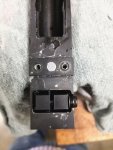I am not a gunsmith but I have an engineering background. Followings are my findings and shall not be construed as recommendations/instructions. Warranty will be voided.
I wanted a folder but could not justify the additional expense (priority on optics). Recently someone posted a stripped folder for sale.
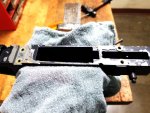
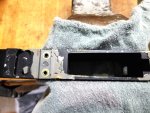
Key takeaways:
The receiver and chassis are truly bonded. The only points of contact other than the fasteners are four brass washers. This is quite different fro our usual "glass bedding" where we want maximum contact between the surfaces and the bedding compound fills the voids.
The bonding agent appears to be a rigid but not brittle epoxy.
And now we separate my receiver.
I removed the extremely tight fasteners. DO NOT use an inexpensive Allen Wrench unless you enjoy the spiral look afterwards. I used a box wrench for leverage.
The entire assembly went inside a thermal chamber (thank you lab) at 90°C for about an hour.
Gently tap the chassis with a a plastic mallet. It separated relatively easily. Epoxy is flexible at this temperature.
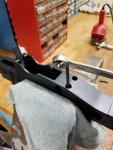
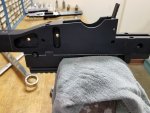
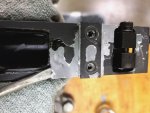
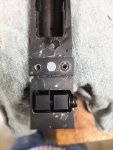
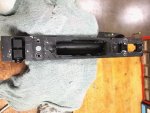
Key takeaways
The receiver workmanship is impeccable, no sharp edges and barely a few tooling marks, finish is even.
Barrel securing mechanism is a very elegant solution, beautiful design and implementation
This components is not an inexpensive component to manufacture.
The chassis is OK, lots of smaller components fastened and bonded together. Some polymer (plastic) components in non critical areas.
Molded skins are designed to fit multiple configurations therefore lots of parts, molding is good, no flash lines, sinks. Material looks like a Nylon 6 family.
My next step is to determine what bonding agent to use.
I wanted a folder but could not justify the additional expense (priority on optics). Recently someone posted a stripped folder for sale.


Key takeaways:
The receiver and chassis are truly bonded. The only points of contact other than the fasteners are four brass washers. This is quite different fro our usual "glass bedding" where we want maximum contact between the surfaces and the bedding compound fills the voids.
The bonding agent appears to be a rigid but not brittle epoxy.
And now we separate my receiver.
I removed the extremely tight fasteners. DO NOT use an inexpensive Allen Wrench unless you enjoy the spiral look afterwards. I used a box wrench for leverage.
The entire assembly went inside a thermal chamber (thank you lab) at 90°C for about an hour.
Gently tap the chassis with a a plastic mallet. It separated relatively easily. Epoxy is flexible at this temperature.





Key takeaways
The receiver workmanship is impeccable, no sharp edges and barely a few tooling marks, finish is even.
Barrel securing mechanism is a very elegant solution, beautiful design and implementation
This components is not an inexpensive component to manufacture.
The chassis is OK, lots of smaller components fastened and bonded together. Some polymer (plastic) components in non critical areas.
Molded skins are designed to fit multiple configurations therefore lots of parts, molding is good, no flash lines, sinks. Material looks like a Nylon 6 family.
My next step is to determine what bonding agent to use.

